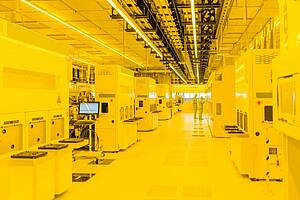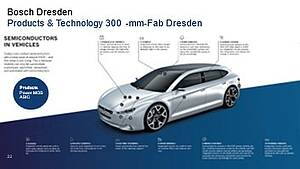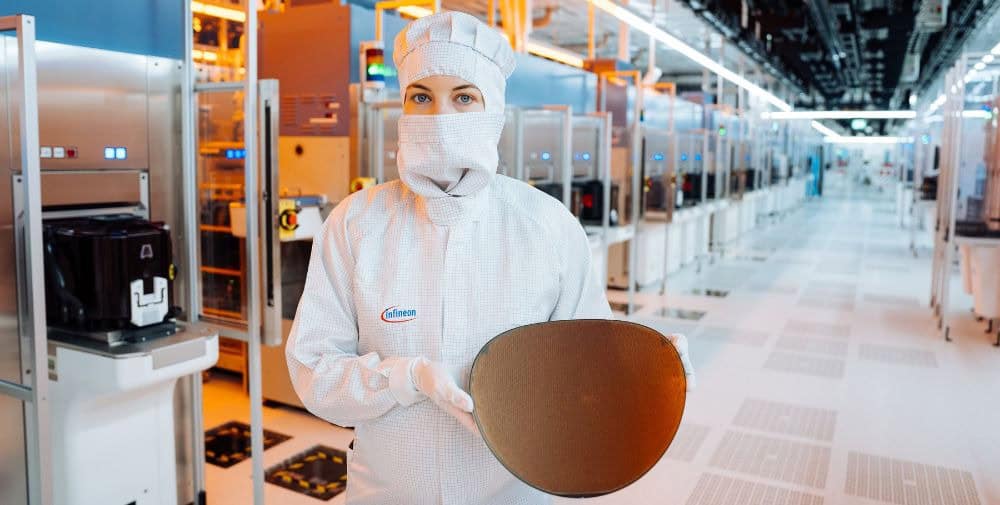But before that, let’s take a brief look at Bosch in Dresden.
- Opening date: June 7, 2021
- Number of production sites worldwide: Front-end manufacturing: Dresden & Reutlingen
- Initial investment cost: 1 billion EUR
- Factory size (area): 100,000 m² (14 soccer fields)
- Size of clean room(s): 10,000 m² + 3,000 m² (expansion)
- Produced structure sizes/design equipment: 180 nm to 65 nm
- Wafer size: 300 mm
- Application industries: Mobility, Consumer Goods
- Number of employees: Currently >400, continuously growing to 700
- Number of nationalities: around 20
- Proportion of women: industry standard
- Skilled workers sought: microtechnologists, IT and software experts
- Skills sought: experience in semiconductor technology, software applications, and product design


© Robert Bosch Semiconductor Manufacturing Dresden GmbH
Dr. Koitzsch, what is the importance of the Dresden location for the Group?
Bosch has invested in one of the most modern factories in the whole of Europe with the construction of the fully automated 300 mm – semiconductor plant. In addition, at one billion euros, it is the highest investment in Bosch company history. Fully networked machines combined with artificial intelligence methods and augmented reality will make the AIoT factory a pioneer of Industry 4.0 and create the basis for data-driven, continuous improvement in production.
Not least, the importance of the Dresden location is made clear by follow-up investments by the company in the triple-digit million range. On the one hand, this is intended to create a research center as well as expand the clean room area and enable the production of micromechanical sensors by 2026.
In which specific areas have investments been made since opening and how high were these investments in total?
The Bosch Dresden plant was opened in 2021. Supplementary investments in the summer of 2021 in the three-digit million range and the presentation of further expansion plans in the summer of 2022 illustrate the importance of the location for the company.
By 2025, an expansion of the manufacturing area by an additional 3,000 square meters is planned. In addition, a development and laboratory building will be constructed in order to be able to map additional manufacturing-related development activities in the Dresden site concept. The existing ASIC design activities of the locally based Bosch Sensortec will be complemented by the research and development focus in the area of 300 mm MEMS technology.
Bosch is investing a three-digit million amount in the new buildings for the research center, laboratory as well as facilities. The development and laboratory building is currently in the conceptual design phase and implementation is planned within the framework of IPCEI II by the end of 2026.
For what uses does the Dresden site produce? What exactly can the chips produced do and in which sectors/industries are they used?
No car drives today without semiconductors. Bosch is shaping the automotive applications of the future with integrated circuits: control units equipped with these chips enable applications such as automated, resource-saving driving as well as the best possible occupant protection.
The Dresden chips are installed in all the electronics in the car, such as the engine control, electric steering and brakes. From 2026, MEMS sensor technology is also to be manufactured at the site. Bosch is the global market leader in this field. Today, these sensors find applications in consumer electronics, for example in smartphones and smartwatches.

© Robert Bosch Semiconductor Manufacturing Dresden GmbH
There are now five fabs, numerous supplier companies and research facilities, as well as microelectronics-related software companies in Saxony. In which areas is the network particularly important for your company?
Dresden is known for its microelectronics cluster, called “Silicon Saxony”, which is unique in Europe, with companies from the supplier, service provider and user industries as well as universities with corresponding technological expertise. These were decisive criteria in the decision to locate the company. The Dresden region with its microelectronics cluster offers the ideal environment for Bosch to set up and operate a state-of-the-art 300-mm semiconductor manufacturing facility.
Silicon Saxony has the potential to become the center of modern, forward-looking manufacturing – the home of I4.0. In this context, collaboration, for example with the Fraunhofer institutes, is very fruitful for the further development of our technologies and for our daily work.
Are there any concrete cooperation projects here with other players at the site, and if so, which ones?
There are indeed. Cooperation and cross-company exchange are assets in the Silicon Saxony Cluster. For example, we can name the cooperation with the Fraunhofer and Fresenius institutes in the area of material evaluations and analysis methods. At the same time, we are very interested in strategic partnerships with the TU Dresden. Our colleagues at Bosch Sensortec also take advantage of the proximity in Silicon Saxony for direct cooperation in the development area and are closely intertwined with the locally based semiconductor companies.
The topic of skilled workers not only moves us. Currently, Saxony’s ICT sector is growing by about 5,000 skilled workers per year, which equates to over 100,000 skilled workers in 2030 if growth remains constant. What role does direct proximity to other fabs play in the context of your skilled workers strategy? Does it make the location rather more attractive or the competition greater?
The growth of Silicon Saxony is a success story and leads to an even greater attractiveness of the entire region. A broad offer with many opportunities gives skilled personnel the chance to get to know different companies. And in the long term, too, we are building on the cluster’s strength for attracting and training skilled personnel, even beyond regional and national borders. In doing so, we also rely on close cooperation with the TU Dresden or the local research institutes. Our active participation in the annual Dresden Mikroelectronic Acadamy is an example of the cooperation and joint commitment to the international recruitment of skilled personnel.
Intel is planning a so-called mega-fab with Magdeburger? What are the implications for you in terms of supply chains, service providers, raw materials and also skilled workers?
“Germany can do high-tech,” said Dr. Dirk Hoheisel, member of the board of management of Robert Bosch GmbH at the press conference to mark the laying of the foundation stone for our semiconductor plant, and Intel’s investment in Magdeburg underlines this. The decision to locate the plant and the billion-euro investment are good news for Germany. It speaks for great confidence in the high-tech location, in the local engineers and skilled workers, and in the unique network of semiconductor manufacturers, suppliers, service providers, universities and research institutes, but also beyond Silicon Saxony. Microelectronics is a key technology of the future for Germany. Decisions like these will inspire further investors and convince the federal government and the European Union to stimulate further investment. For us, this is a guarantee for secure jobs and for the attractiveness for skilled workers.
The job offer becomes more attractive for students, not least in Central Germany, and thus offers the possibility to inspire more young people for the field of “semiconductors” and, of course, to convince them to stay in the region.
What is your vision for the location? How (preferably with concrete examples) should it be further developed?
By 2026, Bosch Dresden will significantly expand both its Dresden and Reutlingen sites. In addition to additional manufacturing capacity, investments will also be made in research and development. In Dresden, the location was chosen carefully and with future prospects in mind. The land already acquired by Bosch in the north of Dresden leaves room for further commitment.
What are concrete support measures that are necessary on the way to this vision? Key words: support programs, education sector, skilled labor strategies, measures at the state or federal level, etc.
Bosch or the Saxon semiconductor cluster need the full support of the Saxon state government, the federal government and the European Union now and in the future. The common goal must be that Europe remains strong in the semiconductor industry and becomes even stronger in competition with other regions. In addition to Bosch and all semiconductor partners, further future factories are needed to achieve technological sovereignty. The modernization and simplification of state aid law, such as IPCEI and new formats such as the EU Chips Act are important elements for this. All partners, whether business, science or politics, must pursue the same long-term goals. Skilled labor acquisition and adjustments in the education sector should be coordinated, interlocking and forward-looking on the common development path. Only in this way will we arrive at a win-win situation for all involved.
Thank you very much for the interview, Dr. Koitzsch.
This interview was first published as part of our magazine NEXT “In Focus: Microelectronics” .
👉 Go to the full issue of the magazine






